
Ruger 77 Rifle in .357 Magnum : Gun Review
Bob Shell test and reviews the Ruger 77 Rifle, a Bolt Action rifle in .357 Magnum.
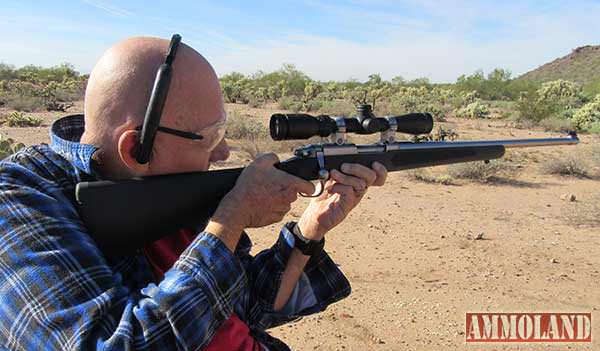
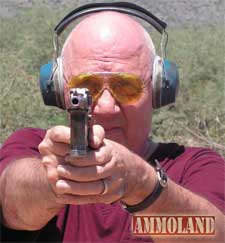
USA –-(Ammoland.com)- The .357 round has been around for many years with good reason. Besides handguns a number of rifles are made for it.
Most are lever actions, but Ruger has taken a different route and produced a bolt action rifle. The Ruger 77 Rifle.
The one obvious advantage of the bolt system is you can safely get the most out of this round. For info on the Ruger rifles you can go to http://www.ruger.com/index.html
The Ruger 77 Rifle sample I received is stainless with a composite stock. My personal preference would be a dull blue barrel which would be less likely to spook a deer. Deer, especially a large one, may see a glint off of a stainless barrel and that will spook him.
They don’t get large by being stupid or ignoring a danger sign. I do prefer the composite stock for hunting. Barrel is 18.5” long, which is plenty to get the maximum performance. For the most part, it is a typical Ruger 77 action, which includes scope rings.
For years, Ruger has used that system and I think it is one of the very best systems for scope mounting. It eliminates the base and the system of the rings going into the action is very sturdy.
It also has a basic set of open sights, which are adjustable though most shooters will probably scope it.
The Ruger 77 Rifle’s bolt is a little unique as it has an extension because of the short cartridge length.
The model 77 is primarily a gun chambered for rifle rounds including full length so this extension is a clever way to make it work with short rounds.
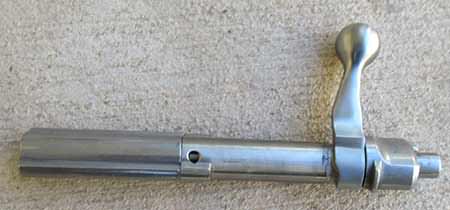
The trigger from the factory has some travel and the pull is decent. It is good enough for the intended purpose.
It has a rotary type of magazine with a five round capacity. There is a large button at the rear that releases the magazine and is easy to use.
The safety is a three position type that locks the bolt in the rear position.
That is handy when going through thick brush to prevent a branch from opening the bolt. If you release the safety in the normal manner, it does make a clicking noise. That will alert an animal to your presence so I would like to see it made more silent.
An animal such as a deer or pig has better hearing then we do and they can hear the safety being released at a distance especially if there is no breeze.
If you slowly release the safety, most of the noise will go away. It might be a good idea if you practiced that maneuver a few times.
It is a light and handy rifle to carry, and with a Ruger Blackhawk in the same chambering you would have a nice combination.
For testing, I put a Hawke 2 X 7 Scope in order to get the best accuracy possible. I have used Hawke scopes on a number of rifles and found them to be top performers for info you can go to http://www.hawkeoptics.com/ That particular scope fits well on this rifle, with the right amount of magnification without over doing it.

The Ruger Model 77/357 offers some versatility because of its ability to handle shorter rounds. Of course, it will shoot .38 specials although they may not always feed. If you don’t mind shooting single shot then you can use .38 short and long Colt rounds as well. With cast bullets in .38 special cases, it can be shot all day and not break the bank. It would be perfect to teach a youngster marksmanship. An interesting thought would be chambering it for a .357 maxi. The gun would be strong enough, although it would be a single shot as they are too long for the magazine. In the .357 maxi chambering ballistics would be close to the .351, which would definitely qualify for some big game with the right bullet. It is a fascinating concept.
For us handloaders, there is a really large variety of bullets and powder that are suitable for the .357 round. I am focusing on hunting loads, as this would be the intent of the Ruger 77 Rifle.
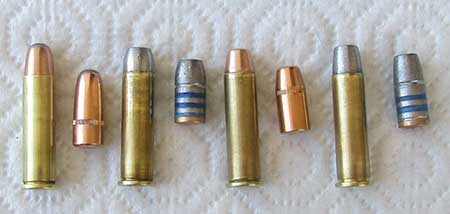
These listed loads should cover everything that a .357 would be suitable for from varmints to deer size game. With the extra velocity obtainable in a rifle, the 180 and 200-grain bullets should perform well in hogs and black bear. The same loads in a revolver give an average of 400 FPS less according to a lot of testing I have done with them. I used new Starline Brass in this test because it is a top quality product with reasonable prices. You can go to www.starlinebrass.com for info on their brass. If you have a .357 or other round to load for I would recommend going to Brownells as they have a good supply of reloading tools and supplies. For parts and other shooting related goodies you can go to www.brownells.com
The .357 magnum rifle has been around for a long time and it is a good idea. Both Winchester and Marlin make lever actions as well as the Uberti model 66 clone.
They are suitable and with a handgun can make for a nice combo. You do give up 300 to 400 FPS when using a handgun especially with heavy loads. I have tested a lot of loads in short and long guns and they all lose a lot of velocity from a handgun to a rifle. Even a 30-30 shows a large difference between a revolver and rifle.
There are many combo-calibers that can be used in a rifle and handgun with the same round. As a rule, they are a good idea because of the flexibility.
If you take a .454 Casull you would have something that could take almost anything in North America, using the proper bullets. At present I have a Taurus lever action .454 rifle and Freedom Arms handgun. If ever I had the opportunity to hunt large bear, or some other large and dangerous game, I would take that over the .357.
As with the .357 there are a lot of ammo options, especially if you roll your own. There are some .41, .44’s and various .45 calibers that are very useful in a number of circumstances. Of course there are a number of .357 combination guns available.

The Ruger 77 Rifle is unique because it is a bolt action as opposed to a lever action, which may give it a little extra strength in case real hot loads are used frequently. Personally, I would carry it with a Blackhawk or another good revolver in the same caliber. A handgun with a 4 to 6” barrel would be the best depending on what would be easier to carry.
As a rule, a longer barrel will give you a little more velocity if that is important.
With good loads, it will handle a lot of hunting especially in the rifle. A good 180 or 200-grain bullet will give you some good penetration on large game. I would recommend this rifle for someone who wants a heavy duty .357 rifle. Hornady and LBT make 200-grain bullets. The Hornady is .358 so it may have to be swaged down to .357 which is very easy.
The 180-grain Sierra or Hornady would also make good candidates for hunting bullets. I am focusing on some heavy bullets, as they would be more suitable for hunting. Since most .357 bullets are made for handguns, they may come apart with the extra velocity afforded by the rifle. I took a Hornady 200 grain RN and swaged to .357. In order to feed they have to be seated past the cannelure, but there is a lot of bullet in the case so they are tight enough to prevent moving.
As a note, I use the same 200 grain Hornady swaged down to .352 in the .351 WSL. It makes a nice bullet in the old model 07.
For small game, I would use a cast semi wad cutter as it would make a good game getter and not destroy a lot of meat. They can be loaded down and still be fine. A 200-grain slug launched at 1400 will produce nearly 900 FT. LBS. of energy at the muzzle and at 100 yards will produce somewhere in excess of 600 FT. LBS. While not earth shattering, they will bring down a deer size animal given a good hit. You should get good penetration on such an animal, which is one factor in successfully harvesting a deer. Giving the lightweight of the rifle and the accuracy, I would definitely use it for close range deer hunting. The 180 grain launched at 1650 will produce 1088 FT. LBS. of muzzle energy. The 158 grain at 1800 FPS will produce 1136 FT. LBS. at the muzzle. That is nothing to sneeze at. Just for comparison a 55-grain .224 bullet launched at 2900 will produce 1027 FT. LBS. of energy at the muzzle. With the 16” barrels used by most folks that is about all you can expect. Since the .223 is the most popular deer round in use, I thought it would be interesting to compare them.
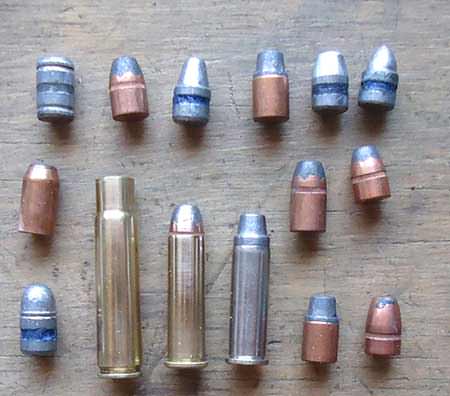
Anyone who makes handgun bullets does so in the .357 caliber. There is virtually any style or reasonable weight available. There are more cast bullets then can be listed and the copper plated slugs. You can mold your own bullets and keep the cost down to next to nothing. Years ago, I use to go to the local outdoor range before sunrise and dig the lead out of the dirt bank. It was a lot of work digging them up, then cleaning them before molding but the ammo cost next to nothing. For those who like to experiment you can buy the equipment and make your own-jacketed bullets. I do it for experimental purposes and you would have to decide if you wanted to sink the considerable amount of cash required to buy the equipment. For various reasons it isn’t for everyone. I did try one load using Remington 7 & ½ small rifle primers and the same using WW small pistol primers.
LOAD ———- BULLET ———- VELOCITY ———- COMMENT
5 grains 231 —– 125 gr SWC 38 case —– 1305.1 —– nice load
HPR 125 —- gr HP —– 1644 —– mild
16 grains 2400 —–140 gr Hornady FTX —–1859 —– deer
Double Tap —–158 gr HP —–1926 —– consistent
Aguila —–158 gr FP —–1708 —– decent load
18 grains Lil’Gun —– 158 gr Sierra FP —– 1819 —– consistent
18 grains Lil’Gun —– 158 gr FMJ —– 1761 —– ok
3.8 grains Bullseye —– 158 gr cast SWC 38 case —– 1016.60 —– consistent
13.7 grains Blackhorn 209 —–160 gr Sierra small rifle primer pistol —– 610.25
13.7 grains Blackhorn 209 —–160 gr Sierra small rifle primer rifle —– 869.7
13 grains IMR 4227 —– 180 gr Sierra —– 1229 —– slow
15 grains IMR 4227 —–180 gr Sierra —– 1435.27 —– consistent
13 grains IMR 4227 —–180 gr LBT —– 1340 —– also slow
15 grains IMR 4227 —– 180 gr LBT —– 1665.98 —– nice
15 grains IMR 4227 —– 180 gr Sierra (pistol) —– 1090.8 —– good load
15 grains IMR 4227 —– 180 gr LBT (rifle primer) —– 1615.3 —– very consistent
11 grains IMR 4227 —– 200 gr LBT —– 1153 —– mild
13 grains IMR 4227 —– 200 gr LBT —–1408.08 —– nice
13 grains IMR 4227 —– 200 gr Hornady RN —– 1366.4 —– consistent
Ruger 77 Rifle
If you want a useful utility rifle the Ruger 77 Rifle may be just the ticket. It is short, light and handy. There are a multitude of bullets and loads that can be used. For a rifle to be carried on a four-wheeler or pickup this would be one of my top picks. Besides being light and handy, it possesses enough power for deer size game at moderate ranges. It would work ok for hogs and black bear, though shot placement would be important. Remington makes a 130 gr FMJ – FP which would do well in some circumstances. The 140-grain FTX would extend the range a little due to the point and high velocity. You have some lead free choices as well as Barnes makes them.
As with guns that I do T & E work on other shooters always get an opportunity to try them out and it was the Ruger 77 Rifle’s turn.
I have several female shooters that I trust to get feedback from, on the products I test. All of the feedback on the Ruger 77 Rifle has been positive as the female shooters like the lightweight good trigger and lack of heavy recoil.
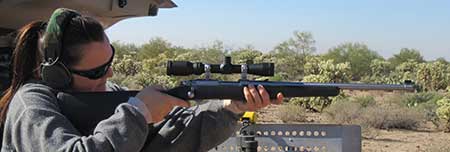
I give the Ruger 77 Rifle a thumbs up, as it will serve well as a nice carbine for woods hunting.
About Bob Shell:
A Custom Reloader of Obsolete and Antique Ammo, Bob Shell, writes about the subject of Guns, Ammo, Shooting and Related Subjects. For more information, visit:www.bobshellsblog.blogspot.com.